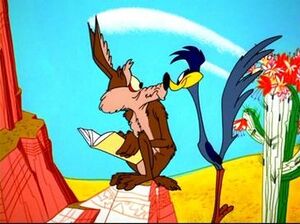Bip Bip et Coyote : Différence entre versions
Sauter à la navigation
Sauter à la recherche
| Ligne 3 : | Ligne 3 : | ||
[[Fichier:BipBipCoyoteVignete.jpg|vignette|Les deux personages face à face,Coyote (à gauche) et son Némésis Bip Bip (à droite)]] | [[Fichier:BipBipCoyoteVignete.jpg|vignette|Les deux personages face à face,Coyote (à gauche) et son Némésis Bip Bip (à droite)]] | ||
| + | == Bibliographie == | ||
| + | La série animé des Bip Bip et Coyote (''Road Runner and Wile E. Coyote'' en anglais) a été conçu et réalisé par Chuck Jones et Michael Maltesse et elle est apparu pour la première fois en 1949 lors de l'episode 'Fast and Furry-ous' parmi les desin animés%%. | ||
==Créateurs== | ==Créateurs== | ||
| − | |||
| − | == | + | ==Liste d'Episodes== |
| − | === | + | #Sep. 1949, 'Fast and Furry-ous', 6 minutes 55 secondes |
| + | |||
| + | ==Coyote== | ||
| + | ===Selon les Créateurs=== | ||
| + | *''The coyote is quite an elegant character, but because of his build he has a problem conveying what he feels he is. In silhouette he looks like a dissolute Bugs [Bunny]''.--'''Chuck Jones (animateur)''' | ||
| + | *''The ragged tail was inspired by Japanese paintings of stormy oceans. When the Japanese artist wants to make a breaking wave frightening, he draws it like hostile claws rather than in the softer Western way. If you have a boat hanging on top of a wave in a Japanese painting, you know it’s going to go over. These are waves to die on, not to surf on. The normal way to draw the tail of any animal, from a squirrel to a dog, is to make it round and soft like the Western waves; reversing this created the Coyote’s tail. It is the difference between concave curves and convex curves, between the cuddly and the ratty''.--'''Chuck Jones (animateur)''' | ||
| + | ===Déscriptions Physiques=== | ||
Le personage est basé sur l'animal qui port le même nom. Un coyote, est un canin endémique et originaire dans l'amerique du nord. | Le personage est basé sur l'animal qui port le même nom. Un coyote, est un canin endémique et originaire dans l'amerique du nord. | ||
| − | ===Bip Bip | + | ===Animal d'inspiration=== |
| + | |||
| + | ==Bip Bip== | ||
Le personage | Le personage | ||
| − | + | ===Selon les Créateurs=== | |
| − | == | + | *''The Road Runner did not change a lot visually over the years; he has very little personality, as he is a force. I tell students that the secret of drawing the Road Runner is learning how to draw dust: just draw a cloud of dust and hook a Road Runner onto it.''--'''Chuck Jones (animateur)''' |
| − | + | ===Déscriptions Physiques=== | |
| + | ===Animals d'inspiration=== | ||
| + | |||
| + | |||
| − | |||
| − | |||
| − | |||
| − | |||
| − | |||
| − | |||
| − | |||
[[Category:Personnage]] | [[Category:Personnage]] | ||
[[Category:Personnage de Chuck Jones]] | [[Category:Personnage de Chuck Jones]] | ||
__SHOWFACTBOX__ | __SHOWFACTBOX__ | ||
Version du 16 février 2025 à 14:49
Cette page a été créée le 3 février 2025 par Frederic Rosenthal du groupe 4.
Sommaire
Bibliographie
La série animé des Bip Bip et Coyote (Road Runner and Wile E. Coyote en anglais) a été conçu et réalisé par Chuck Jones et Michael Maltesse et elle est apparu pour la première fois en 1949 lors de l'episode 'Fast and Furry-ous' parmi les desin animés%%.
Créateurs
Liste d'Episodes
- Sep. 1949, 'Fast and Furry-ous', 6 minutes 55 secondes
Coyote
Selon les Créateurs
- The coyote is quite an elegant character, but because of his build he has a problem conveying what he feels he is. In silhouette he looks like a dissolute Bugs [Bunny].--Chuck Jones (animateur)
- The ragged tail was inspired by Japanese paintings of stormy oceans. When the Japanese artist wants to make a breaking wave frightening, he draws it like hostile claws rather than in the softer Western way. If you have a boat hanging on top of a wave in a Japanese painting, you know it’s going to go over. These are waves to die on, not to surf on. The normal way to draw the tail of any animal, from a squirrel to a dog, is to make it round and soft like the Western waves; reversing this created the Coyote’s tail. It is the difference between concave curves and convex curves, between the cuddly and the ratty.--Chuck Jones (animateur)
Déscriptions Physiques
Le personage est basé sur l'animal qui port le même nom. Un coyote, est un canin endémique et originaire dans l'amerique du nord.
Animal d'inspiration
Bip Bip
Le personage
Selon les Créateurs
- The Road Runner did not change a lot visually over the years; he has very little personality, as he is a force. I tell students that the secret of drawing the Road Runner is learning how to draw dust: just draw a cloud of dust and hook a Road Runner onto it.--Chuck Jones (animateur)
